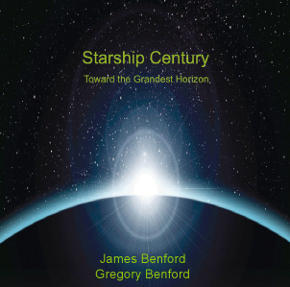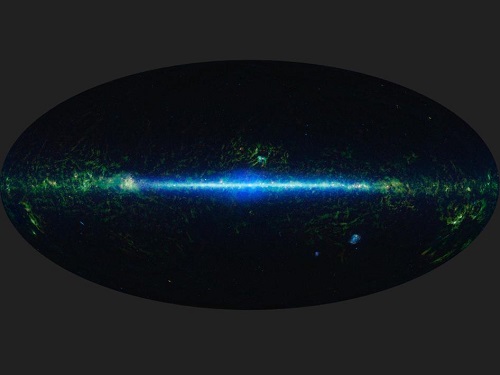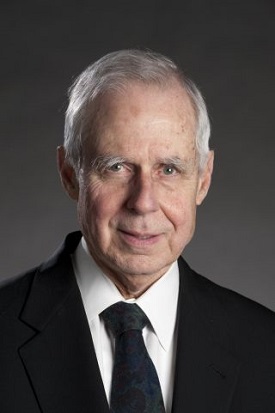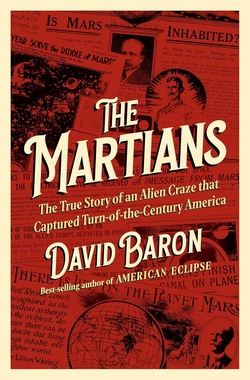Centauri Dreams
Imagining and Planning Interstellar Exploration
A Gravitationally Lensed Supernova?
I keep a close eye on gravitational lensing, not only because of the inherent fascination of the subject but also because the prospect of using the Sun’s own lensing to study distant astrophysical phenomena could lead to near-term missions to 550 AU and beyond. And because I’m also intrigued by ‘standard candles,’ those markers of celestial distance so important in the history of astronomy, I was drawn to a new paper on the apparent gravitational lensing of a Type Ia supernova (SNIa). This is the kind of supernova that led to the discovery of the accelerating expansion of the universe by giving us ways to measure the distance to these objects.
The point about Type Ia supernovae is that they are so much alike. We may not fully understand the mechanisms behind their explosions, but we have overwhelming evidence that these supernovae reach nearly standard peak luminosities. There is also a strong correlation between their luminosity and other observables like the shapes of their light-curves, so their value as standard candles — astronomical objects with a known luminosity — is clear. Our studies of dark energy depend crucially on Type Ia supernovae, putting a premium on learning more about them.
The supernova PS1-10afx turned up in data from the Panoramic Survey Telescope & Rapid Response System 1 (Pan-STARRS1). What drew particular attention to it was that it appeared to be extremely bright — with an inferred luminosity about 100 billion times greater than the Sun — but also extremely distant. The luminosity was not itself a problem, as it corresponded to the recently discovered category of superluminous supernovae (SLSNe). But the latter tend to be blue and show a brightness curve that changes slowly with time. Not so PS1-10afx, which was highly luminous, displayed the brightness changes of a normal supernova, and was red.
Ryan Chornock (Harvard–Smithsonian Center for Astrophysics) and colleagues reported on the new supernova’s unusual attributes in a recent paper in The Astrophysical Journal. But Robert Quinby (Kavli Institute for the Physics and Mathematics of the Universe in Tokyo) went to work on matching PS1-10afx to other supernovae. Quinby realized that after correcting for time dilation, the light curve of the new supernova was consistent with a Type Ia supernova despite the observed brightness of the object. Gravitational lensing provides an answer: The supernova is being lensed by an object between it and ourselves. The color and spectra of the supernova remain the same as does its lightcurve over time, but the lensing makes it brighter.
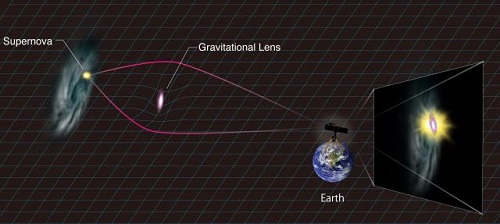
Image: One explanation of PS1-10afx. A massive object between us and the supernova bends light rays much as a glass lens can focus light. As more light rays are directed toward the observer than would be without the lens, the supernova appears magnified. (Credit: Kavli IPMU)
Thus we have the lightcurve of a typical SNIa but an object that is 30 times brighter. Although PS1-10afx would be the first Type Ia supernova found to be magnified by a gravitational lens, one of the co-authors of the paper on this work, Masamune Oguri, was lead author on a paper predicting several years ago that Pan-STARRS1 might discover such an object. The alternative is to assume a new kind of superluminous supernova, an idea that can only be ruled out by further observations. The Quimby paper notes that the magnification of PS1-10afx is independent of the supernova itself and should thus apply to the host environment:
This prediction of a persistent lensing source provides a test of our hypothesis. High spatial resolution images from HST may be able to resolve the Einstein ring from the magni?ed host galaxy. If the lens is a compact red galaxy then color information should distinguish it from the blue, star-forming galaxy in the background. If a foreground galaxy is not detected, then this would either suggest that more exotic lensing systems, such as free ?oating black holes, are required or it could support the hypothesis of C13 [referring to the Chornock paper] that a new class of superluminous supernovae is required to explain PS1-10afx.
The beauty of the gravitational lensing explanation is that no new physics would be needed. The Quimby paper shows that discovering a gravitationally lensed Type Ia supernova is statistically plausible for Pan-STARRS1. The paper also makes the interesting case that some massive red galaxies coincident with ‘dark’ gamma-ray bursts may actually be foreground lenses for higher redshift events. We may, in other words, soon begin to discover more lensing transients like PS1-10afx as new surveys with tools like the Large Synoptic Survey Telescope begin. Such studies should be crucial in developing our ideas about the universe’s expansion.
But back to Quimby’s explanation of PS1-10afx, about which Ryan Chornock remains dubious. Chornock is quoted in a recent Scientific American article as saying he and his team studied the lensing possibility and dismissed it:
“This was a hypothesis that we actually considered prior to his paper… But the team rejected it based on a number of factors, including the fact that no object has been found that fits the bill for a possible gravitational lens. “Based on our knowledge of the universe, which is of course imperfect, that kind of lensing is usually produced by clusters of galaxies. That’s clearly not the case here because there’s no cluster of galaxies,” he adds, noting that the explanation favored by Quimby and his colleagues “does require some sort of unexpected or unlikely alignment.”
Quimby is right to note that this is a testable result, and his team’s application for time on the Hubble Space Telescope could provide an answer between the two explanations. The Chornock paper is “PS1-10afx AT z = 1.388: PAN-STARRS1 Discovery of a New Type of Superluminous Supernova,” The Astrophysical Journal Vol. 767, No. 2 (2013), 162 (abstract). The Quimby paper is “Extraordinary Magnification of the Ordinary Type Ia Supernova PS1-10afx,” The Astrophysical Journal Letters Vol. 768, No. 1 (2013), L20 (abstract).

Thoughts on Kepler 62 and Habitability
Because we only have direct images of a tiny number of planets orbiting other stars, we’re used to extrapolating as much as we can from our data and plugging in possible scenarios. But as the recent announcement of two ‘super-Earths’ around Kepler 62 demonstrates, we’re coming up hard against the limits of our knowledge. The comments on my recent story on the Kepler find bring up Greg Laughlin’s always interesting systemic site and a post he made in early April. Laughlin (UC-Santa Cruz) is worth reading not only for his shrewd analysis but for the sheer brio he brings to the exoplanet hunt. And here he sounds a note of caution:
I think we currently have substantially less understanding of the extrasolar planets than is generally assumed. Thousands of planets are known, but there is no strong evidence that any of them bear a particular resemblance to the planets within our own solar system. There’s always a tendency, perfectly encapsulated by the discipline of astrobiology, with its habitable zones and its preoccupation with water — to make wild extrapolations into the complete unknown.
Many Centauri Dreams readers don’t read the comments after each post, so I wanted to get that sentiment out in plain sight. One of the problems Laughlin notes is that if you plot the mass-radius relationships for super-Earths, you get numerous possibilities based on what we have found so far. We find what Laughlin calls a ‘huge range in apparent planetary structures’ here. Little more needs to be said: We’re tempted to look for clement conditions for astrobiology but we have to be careful that we don’t read our own hopes into still ambiguous results.
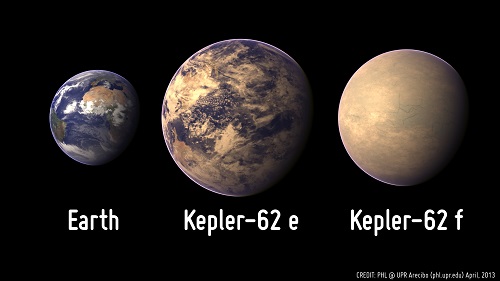
Image: A size comparison of Kepler 62 e and f as measured against the Earth. How much do the images contain our own hopes for astrobiology as opposed to what we really know? Credit: Planetary Habitability Laboratory.
Using data from the Allen Telescope Array, the SonATA program (SETI on the ATA) has continued to run a SETI search that focuses on Kepler candidates, especially those thought to be in the habitable zone of their stars. A recent news release homes in on the Kepler 62 finds, though with a caution that rings true in relation to Laughlin’s thoughts above. Clearly, Center for SETI Research head Gerry Harp would love to point his equipment at worlds with water on the surface, but in the case of Kepler 62 the mass of both habitable zone planets is unknown because they’re too small and too far away to analyze their gravitational effects on the host star.
Jon Jenkins, senior scientist at the Carl Sagan Center of the SETI Institute, is thus wise to take a measured approach:
“These discoveries move us farther down the road to discovering planets similar to Earth. While we don’t know if Kepler 62e and f are rocky or whether they have liquid water pooling on their surfaces, their existence shows that the incidence of small worlds in the habitable zone of sun-like stars is high. Thus we can look forward to the discovery and detailed characterization of Earth’s cousins in the years and decades to come by future missions and telescopes.”
And that seems like a legitimately cautious take-away from the Kepler 62 work. Of the five planets thus far identified around the star, two super-Earths seem to be in the habitable zone, but we can’t push definitively beyond that. The good news, as Laughlin notes on systemic, is that with the approval of TESS (Transiting Exoplanet Survey Satellite), we’re going to be discovering transiting super-Earths around the few million brightest stars close enough for detailed radial velocity follow-up, all of this within a scant ten years. TESS will provide the data we need to get a better understanding of the mass-radius relationships about which we have so many questions.
Blending Detection Methods with TRENDS
And while we’re talking exoplanets, let me take note of the TRENDS project (TaRgeting bENchmark-objects with Doppler Spectroscopy) being led by Justin Crepp (Notre Dame). Caltech’s John Johnson heads up Project Minerva at the university’s Exolab, recently described here as a telescope array dedicated to Earth-like planets around nearby stars, one capable of both radial velocimetry and transit studies. Crepp worked with Johnson as a postdoc and is now, like his mentor, combining exoplanet detection methods. TRENDS uses radial velocity measurements to identify promising targets for high-contrast imaging observations.
Initial results here are promising. The TRENDS team has discovered low-mass stellar companions orbiting HD 53665, HD 68017, and HD 71881 using NIRC2 adaptive optics (AO) observations. Its follow-up imaging has demonstrated common proper motion; i.e., co-moving companion objects with estimated spectral-types of K7-M0, M5, and M3-M4 respectively. These three M-dwarf companions could be found in the long-term Doppler trends of the host stars and the follow-up work at Keck then allowed their direct detection. From the paper:
Few mass, age, and metallicity benchmark dwarfs are known to date (Liu et al. 2007; Dupuy et al. 2010; Bowler et al. 2012a,b). The goal of the TRENDS high-contrast imaging program is to discover and characterize low-mass stellar and substellar companions with physical properties determined independently from spectro-photometric measurements, in order to calibrate theoretical atmospheric models and thermal evolutionary models. Each of the companions presented are amenable to direct spectroscopy using AO-fed integral-field units, such as OSIRIS at Keck or Project 1640 at Palomar.
This kind of news doesn’t drive the headlines, but we’re looking at important work. Crepp’s team is coming up with metallicity and age benchmarks, and further observation should produce mass benchmarks as well. Moreover, Johnson called my attention to another paper in which Crepp and colleagues characterize the brown dwarf HR7672B, establishing it as a “rare and precious ‘benchmark’ brown dwarf with a well-determined mass, age, and metallicity…” This is how you test your knowledge of the spectral and evolutionary models we need to make sense of what we see. Combining radial velocity and direct imaging clearly yields powerful new analysis.
The TRENDS work demonstrates improved ways to use our tools at the same time that it reminds us how much we have to learn. There is a raw excitement in pushing our methodologies in such synergistic ways. As we look forward to what projects like TESS will reveal in a few short years, we should keep in mind what while those Earth analogues are surely out there, tuning up our techniques will enable discoveries we haven’t begun to anticipate.
For more on TRENDS, see Crepp et al., “The TRENDS High-Contrast Imaging Survey. I. Three Benchmark M-dwarfs Orbiting Solar-type Stars,” accepted at The Astrophysical Journal (preprint). See also Crepp et al., “The Dynamical Mass and Three-dimensional Orbit of HR7672B: A Benchmark Brown Dwarf with High Eccentricity,” The Astrophysical Journal Volume 751, Issue 2 (2012), article id. 97 (abstract).

Starship Century Symposium May 21-22
The Arthur C. Clarke Center for Human Imagination is launching in May with what it describes as a ‘series of perspectives’ on what we can expect in the coming century. Its inaugural symposium begins on May 14 at the University of California at San Diego with discussions on design, artificial intelligence, synthetic life and science studies and thoughts from writers Jonathan Lethem and Kim Stanley Robinson on the literary imagination. But those with interstellar interests will want to put days 2 and 3 (May 21, 22) on their calendar, when the Starship Century Symposium convenes on the same site.
Gregory and James Benford have coordinated the latter event with the Clarke Center and will use it to present ideas on our possibilities among the stars as presented in their upcoming book Starship Century. Speakers will include prominent science fiction writers as well as many of the scientists most actively engaged in thinking about starflight. Thus we have Pete Worden (NASA Ames) as well as Neal Stephenson (The Diamond Age, Cryptonomicon, etc.) on the first morning, along with Robert Zubrin, of Mars Society fame, discussing what he calls the ‘economics of interstellar breakout.’ Futurist and business strategist Peter Schwartz will present “Starships and the Fates of Humankind.”
A section on the near-future including Geoffrey Landis on nuclear rocket options in the Solar System gives way the next morning to Adam Crowl’s talk on the development of starship concepts over the past century, Paul Davies on alien biospheres, Ian Crawford on interstellar destinations and John Cramer on exotic physics and the interstellar distance conundrum. Freeman Dyson offers a remarkable look (I’ve already seen this one) at what we might find as we move into the Kuiper Belt and the Oort Cloud beyond, especially in terms of how life might appear there or be created by human scientists working wonders with genetic engineering.
I’m told that available space is filling up fast. You can find the complete list of speakers and panelists, including Larry Niven, Jon Lomberg, Joe Haldeman, David Brin, Jill Tarter, Vernor Vinge and more, on the agenda page. Lodging is at the La Jolla Shores Hotel, with full details on the site. The Clarke Center frames the overall three-day event this way: Day 1 covers one-third of a century, the time between the creation of 2001: A Space Odyssey and the year it portrayed. Days 2 and 3 address what the Center calls “…a century long project: to create a starship.”
Addendum: Jim Benford has written to say that some of the material on the Starship Century site, from which I drew this article, is out of date. I’ll update with any schedule changes next week.

Water Worlds in the Habitable Zone
“The fault, dear Brutus, is not in our stars,
But in ourselves, that we are underlings.”
Thus Cassius speaking to Brutus in Shakespeare’s Julius Caesar, trying to convince him that what happens to us comes not from some malign fate but from our own actions. I’m sure he’s right, too, but I admit there are days when I wonder. For the stars seem aligned in such a way that whenever there is a significant news conference about exoplanets, I have a schedule conflict. This is true yet again today, so that I’m writing before the NASA-hosted news briefing and will have to set this up to post automatically after the embargo expires.
Here, though, are the main points. We have found Kepler 62f, an interesting world about 1.4 times the size of Earth and most likely rocky. When you add up the other known facts about the planet, the attention builds. Discovered through Kepler data in the constellation Lyra, this world receives about half the heat and radiation that the Earth does, while orbiting its star every 267.3 days. The University of Washington’s Eric Agol lays out the case for this intriguing planet:
“The planets this small that we have found until now have been very close to their stars and much too hot to be possibly habitable. This is the first one Kepler has found in the habitable zone that satisfies this small size. Kepler 62f is the smallest size and the most promising distance from its star, which by these measures makes it the most similar exoplanet to Earth that has been found by Kepler.”
The best guess — and remember that we lack knowledge of Kepler 62f’s mass and density — is that we’re looking at a rocky world with an atmosphere, but Agol doubts it’s a thick gaseous envelope like Neptune’s. We seem to be looking at a planet a bit larger and somewhat cooler than the Earth, and it’s not alone in this system, where four other planets are known to exist. One of these, Kepler 62e, is a fellow traveler in the star’s habitable zone. It’s about 1.61 times the size of Earth and orbits every 122.4 days, giving it 20 percent more stellar flux than the Earth.
Image: The newly discovered planets named Kepler 62e and f are super-Earths in the habitable zone of a distant sun-like star. The largest planet in the image, Kepler 62f, is farthest from its star and covered by ice. Kepler 62e, in the foreground, is nearer to its star and covered by dense clouds. Closer in orbits a Neptune-size ice giant with another small planet transiting its star. Both habitable-zone planets may be capable of supporting life. Credit: David A. Aguilar (CfA)
Two small super-Earths in the habitable zone make for understandable excitement. Modeling at the Harvard-Smithsonian Center for Astrophysics (CfA) suggests that both these planets are water worlds, completely covered with a global ocean. Might they have life? Lisa Kaltenegger (Max Planck Institute for Astronomy/CfA) speculates:
“These planets are unlike anything in our solar system. They have endless oceans. There may be life there, but could it be technology-based like ours? Life on these worlds would be under water with no easy access to metals, to electricity, or fire for metallurgy. Nonetheless, these worlds will still be beautiful blue planets circling an orange star — and maybe life’s inventiveness to get to a technology stage will surprise us.”
Kepler 62 is a class K star somewhat smaller and cooler than the Sun. According to the CfA’s models, Kepler 62e should be cloudier than the Earth, while the cooler Kepler 62f would need to take advantage of the greenhouse effect from carbon dioxide in the atmosphere to keep it warm enough for the ocean to remain liquid. Harvard’s Dimitar Sasselov notes in this CfA news release that discoveries like this raise the prospect of other stars with not one but two planets in the habitable zone. That conjures up what until recently was our view of the Solar System, when not so many decades ago we used to believe Venus and Mars might each be habitable worlds.
I think Sasselov is right to linger over this thought. These may be water worlds and most likely would not develop technological civilizations, but imagine a system where two worlds with continents and oceans, worlds much like Earth, existed close to each other in the habitable zone, each highly visible to the other. Surely the inhabitants of planets like these, with the prospect of a truly colonizable world this close, would be impelled to make the crossing.
The other planets around this star? Kepler 62 b, c and d are 1.31, 0.54 and 1.95 times the size of the Earth, respectively, all orbiting the star too tightly to be in the habitable zone. For more, see this University of Washington news release. Kaltenegger and Sasselov’s work is to be published in The Astrophysical Journal, while Agol is second author of the discovery paper published online in Science today as Borucki et al., “Kepler-62: A Five-Planet System with Planets of 1.4 and 1.6 Earth Radii in the Habitable Zone” (abstract).

Finding ET in the Data
As we saw yesterday, the Infrared Astronomical Satellite (IRAS) has been the source of data for a number of searches for unusual infrared signatures. The idea is to look for the artifacts of advanced extraterrestrial civilizations, under the assumption that a sufficiently advanced culture will be capable of engineering projects that could be detected from light years away. A Dyson sphere, existing either as a completely enclosed star or as a swarm of artifacts around a star, is but one example of such engineering, but it’s a sensible one to look for because it represents a way to maximize energy. It’s also theoretically detectable because of waste heat in the infrared.
These days, though, we have not just IRAS but the Wide-field Infrared Survey Explorer (WISE) and the Spitzer space telescope providing us with infrared data. Richard Carrigan’s pioneering work on interstellar archaeology is now complemented by searches funded by the New Frontiers in Astronomy & Cosmology program, set up by the Templeton Foundation and administered by the University of Chicago. The program has been created to provide grants in areas ranging from our universe’s role in a possible multiverse to the detection of intelligence beyond our Solar System. The team of Jason Wright (Pennsylvania State) and colleagues Steinn Sigurðsson and Matthew Povich is one of three grant winners in a tuned up Dyson artifact hunt.
As described by Stephen Battersby in Alien Megaprojects: The Hunt Has Begun, a recent article in New Scientist, this search should be able to expand Carrigan’s observations thousands of times farther, with the ability to detect a Dyson sphere around a Sun-like star almost anywhere in the galaxy. And this gets us into interesting terrain. From the article:
Even such a wide-ranging hunt may not be ambitious enough, according to Wright. He suspects that interstellar travel will prove no harder than constructing a sphere. An alien civilisation with such a high level of technology would spread out and colonise the galaxy in a few million years, building spheres as they go. “I would argue that it’s very hard for a spacefaring civilisation to die out. There are too many lifeboats,” says Wright. “Once you have self-sufficient colonies, you will take over the galaxy – you can’t even try to stop it because you can’t coordinate the actions of the colonies.”
A good point. And if this is the case, we would expect to find Dyson spheres, assuming we’re correct in thinking they represent a reasonable way to maximize the collection of energy. “To find one or a few Dyson spheres in our galaxy,” Wright goes on, “would be very strange.” In other words, there are either going to be a lot of them or none at all, and if there are a lot of them, then we might consider taking the hunt into extra-galactic territory. Wright tells Battersby that a galaxy colonized by a Kardashev Type III civilization should show up as a big, bright object in the infrared data from WISE, clearly flagged by virtue of the fact that it has no optical component.
How likely is it that things like Dyson spheres will ever be built? Wright has written about this on his AstroWright site, from which this quote:
…despite all of the advances in medicine, economics, and civilization generally, we are still growing as a species exponentially. We have long left Malthusian limits behind, and have shown that technology will progress faster than our resource demands. But no technology can give us more energy than hits the Earth until we start talking about spaceships (except for nuclear energy, which is an ultimately finite resource; fossil fuels are, ultimately, just stored energy from sunlight that hit plants millions of years ago, so, again, finite). We will continue to grow as a species until we hit a free energy resource limit, and then in order to further grow we will have to start collecting more solar energy. And we will have to start emitting that energy as waste heat. And that trend, too, will then have to proceed exponentially…
The consequences are interesting to contemplate.
Indeed. The approach is speculative and obviously depends on how an advanced civilization builds its energy collectors. Dyson spheres are one thing, but a thin ring of artifacts around a distant star is not going to be easily flagged even in the WISE data. A second survey, this one with a different approach, is in the hands of Princeton’s Lucianne Walkowicz, who with her four co-investigators will be looking through Kepler data for unusual patterns of variability. Here we’re in familiar territory with the analysis of light curves that has proven so productive in detecting exoplanets.
Will Walkowicz’ team find something spectacular? After all, their proposal is titled “Stellar Lighthouses: Decoding Signatures of Advanced Civilizations in Precision Stellar Photometry,” and any signature of something artificial around a distant star is going to change everything. But this is a search for more than Dyson spheres, just as ‘interstellar archaeology’ comprehends much more than a single postulated technology.
Suppose a distant civilization is using microwave beaming to drive spacecraft, or modifying its star’s makeup to prolong its life? Steinn Sigurðsson, blogging from the New Frontiers in Astronomy & Cosmology conference in 2012, recalled an old Analog story about the discovery of unusual stars, so bizarre that they demand immediate investigation. One turns out to have a convective zone spiked with manganese and one is bright green. The conclusion is that extraterrestrial pranksters are spiking the stars to draw attention. Who knows what may turn up, but as Walkowicz tells Battersby: “We know what transits, starspots and flares looks like, so we are looking for any variation we can’t explain through known astrophysics.”
Geoff Marcy (UC-Berkeley) is also in the hunt, working with the University of Hawaii at Honolulu’s Andrew Howard and John Johnson (Caltech) on the same kind of signal via Kepler data. The data, of course, are already in our possession, though we keep adding to the database. But it’s a fascinating speculation that we may already have detected signs of an extraterrestrial civilization without even realizing it. The hunt for astronomical anomalies means combing through vast amounts of data with a clear view of our own preconceptions and how they might mislead us. Marcy’s team will doubtless find unusual variability in a number of objects that can be explained through conventional means, but finding the inexplicable will get everyone’s attention.

Archaeology on an Interstellar Scale
Dyson spheres — technology wrapped around an entire star to maximize energy use — would be unimaginably big. But the idea of maximizing the light from a central star certainly makes sense. Imagine a sphere with a radius at the distance of Earth’s orbit. Now you’ve got a surface area more than 100 million times what’s available on our planet, a sensational venue for science fiction if nothing else. And you’re certainly changing the energy equation — our total power consumption today is the equivalent of about 0.01 percent of the sunlight falling on Earth, according to a new article in New Scientist. Keep energy demand growing at 1 percent per year and in a single millennium we’ll need more energy than strikes the surface of the planet.
Moving power generation into space is certainly something that would motivate a civilization a good deal more advanced than our own, and using abundant asteroid material, it could spread power generation entirely around the star. Stephen Battersby, who wrote Alien Megaprojects: The Hunt Has Begun, doubts they would create a single shell because it would be gravitationally unstable. But a Dyson ‘swarm’ is more plausible, with hordes of large power stations moving on independent orbits around the star. Dyson, who likes to talk about what is observable rather than what’s probable, thinks we could spot such a project through its waste heat in the infrared.
This wouldn’t be an easy catch because there are astronomical configurations — a young star in an envelope of gas and dust, for example — that radiate in the infrared in much the same way. But this, says Battersby, can be resolved:
…the infrared spectrum of these objects should be a giveaway. Silicate minerals in dust produce a distinctive broad peak in the spectrum, and molecules in a warm gas would produce bright or dark spectral lines at specific wavelengths. By contrast, waste heat from a sphere should have a smooth, featureless thermal spectrum. “We would be hoping that the spectrum looks boring,” says Matt Povich at the California State Polytechnic University in Pomona. “The more boring the better.”
Image: A mosaic of the images covering the entire sky as observed by the Wide-field Infrared Survey Explorer (WISE), part of its All-Sky Data Release. Since the Infrared Astronomical Satellite mission of 1983, we have added greatly to our databases of infrared objects. Will new searches help us locate a source with a clearly artificial signature? Image credit: NASA/JPL-Caltech/UCLA.
And that brings us to Vyacheslav Ivanovich Slysh, a Russian radio astronomer known for the so-called ‘Slysh formula,’ which helps determine the size of sources of synchrotron radiation, an important contribution to the study of active galactic nuclei. Known as well for his work on maser emission in star-forming regions, Slysh turned his attention in 1985 to a survey of infrared data in the hunt for Dyson objects, whether spheres or swarms. Battersby mentions Slysh only in passing, but the Russian work on what I usually refer to as ‘interstellar archaeology’ in these pages is quite interesting. In 2000, Slysh’s work was followed by M. Y. Timofeev, collaborating with Nikolai Kardashev, both efforts using data from the Infrared Astronomical Satellite.
Centauri Dreams readers will know to associate the search for extraterrestrial artifacts with Richard Carrigan, a scientist emeritus in the Accelerator Division at the Fermi National Accelerator Laboratory whose most recent search dates from 2009. Here’s what Carrigan says about the Slysh and Timofeev efforts in his Dyson Sphere Search History. Here he has just referred to a search by Jun Jugaku and Shiro Nishimura, looking for ‘partial’ Dyson spheres:
Slysh and Timofeev at al. have used the IRAS database for a different approach. Slysh investigates the flux at the maximum of a Dyson Sphere spectrum. He estimates that all Dyson Spheres with temperatures from 50 to 400 ºK within 1 kpc of the sun should have been detected. The Timofeev search looked at a population of IRAS sources in the 110-120 and 280-290?ºK temperature range as established by Kardashev and others and did Planck blackbody fits to the four IRAS bands. They fitted by minimizing to a Planck distribution. (Note that no Planck spectrum correction is made on the four measured fluxes from the filters.) Slysh identified one possible Dyson Sphere candidate, G357.3-1.3. The Timofeev at al. search identified 10 or so candidates but ruled out most of them, often on the basis of associations.
That figure of 1 kiloparsec (kpc) from the Sun identified with Slysh is chosen for a reason. In 1966, Carl Sagan and Russell Walker published a paper in The Astrophysical Journal on “The Infrared Detectability of Dyson Civilizations.” Their analysis showed that a search out to 1000 parsecs should be possible even with the technology of the day, but noted the problem of confusing a possible Dyson signature with natural phenomena. Carrigan’s 2009 search also used the IRAS data of 250,000 infrared sources (it covers 96 percent of the sky), looking for both full and partial Dyson spheres in the blackbody temperature region from 100 K to 600 K. Carrigan’s limits don’t go out as far. He says that IRAS’ Low Resolution Spectrometer was sensitive enough to find Dyson spheres out to 300 parsecs. That would encompass roughly a million solar-type stars.
Image: Richard Carrigan, who told New Scientist for its recent article: “I wanted to get into the mode of the British Museum, to go and look for artifacts.”
I’ve mentioned enough papers to begin a small bibliography, which I’ll list here, but go to Carrigan’s site for other references. I bring all this up for two reasons. First, new searches for extraterrestrial artifacts are in the works, about which more tomorrow. The other reason is that this work isn’t highly visible, but the change it represents from more conventional radio and optical SETI methods is profound. The change speaks not so much to the failure of earlier SETI to produce a result as to our growing understanding that civilizations substantially more advanced than our own — if they exist — could work with engineering on mind-boggling scales. Such engineering should be detectable, and we’ll look at new efforts to find it tomorrow.
The Slysh paper is “A Search in the Infrared to Microwave for Astroengineering Activity,” in The Search for Extraterrestrial Life: Recent Developments, M. D. Papagiannis (Editor), Reidel Pub. Co., Boston, Massachusetts, 1985, p. 315. Timofeev and Kardashev wrote “A Search of the IRAS Database for Evidence of Dyson Spheres,” Acta Astronautica 46 (2000), p. 655. The Sagan and Walker paper is “The Infrared Delectability of Dyson Civilizations,” Astrophysical Journal 144 (3), (1966), p. 1216. And Richard Carrigan’s 2009 study is “The IRAS-based Whole-Sky Upper Limit on Dyson Spheres,” Astrophysical Journal 698 (2009), pp. 2075-2086, available online.

